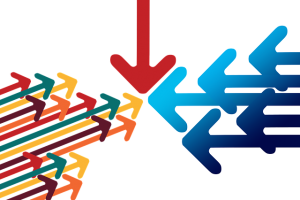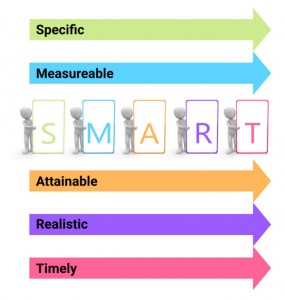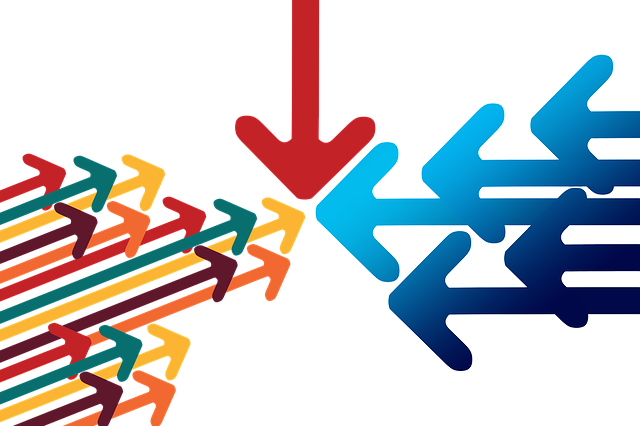When a company starts to grow, one of the biggest questions they face is how to organize their management. The two main branches of management roles are centralized and decentralized authority. Companies usually fall somewhere between these extremes.
Centralized Management

Centralized organizations have all decisions coming from the same place
Centralized management is the organizational structure where a small handful of individuals make most of the decisions in a company. For example, a small family diner owned by a married couple probably uses centralized management. The couple themselves order inventory, decide the marketing direction, and hire new employees. As a company with centralized management grows, they add new levels of mid and lower level managers, each of whom answers to a superior, with very strictly defined roles in the company.
More centralized management is usually seen in highly competitive industries, where companies specialize in similar products to their competition. A common example is Apple computers, where most of the direction of the company is orchestrated at the very top (formerly Steve Jobs himself), which the lower levels of management and employees very tightly organized to execute those goals.
Decentralized Management

Decentralized organizations have decisions coming from all levels of management towards the same goal
Decentralized management is the opposite – the upper levels of management transfers some of the decision-making processes onto lower levels, and even to individual employees. The overall authority is still maintained by top level managers, who make policies that influence the major decisions of the company, but most decision-making responsibility is delegated to the lower levels.
This form of management would, for example, allow a manager at a call center or retail store to make instant decisions that impact their work environment. Decentralized management is found most often in areas with a lot of direct contact with clients and customers, since it allows the managers closest to the “Action” have more flexibility.
Decentralization should not be confused with the allocation of tasks to individual members of the management team, since this is an individual action and does not always reflect the broader trend of the company.
An increase in duties of the lower-level employees can be seen as “decentralizing”, while decreasing their duties is “centralizing”.
Centralized Management – Advantages and Disadvantages
There are some very good reasons why companies choose to centralize their management, but also big disadvantages to going too far.
Advantages

McDonald’s uses centralization to get a standardized menu everywhere
The upper management at a centralized company will have complete control over training, products they offer, and are more likely to ensure the company’s core objectives and values are maintained. A centralized management style also has the potential to improve the organization as a whole instead of just one smaller branch at a time.
Centralized management usually keeps its external communication, like Business to Business relationships, controlled down to just a few individuals, which helps keep the company’s messaging consistent and more efficient. Centralization also helps standardize products and materials, which in turn helps speed up preparation and procurement.
McDonald’s is a prime example of centralized management and standardization. The exact same number of pickles is put on each burger no matter where you are in the world. Airlines do this too – you will get the exact same brand of bottled water on every airplane in the same brand. Companies often centralize when they want to improve the consistency of their product quality, and standardize production.
Disadvantages
Centralized management strategies limit the creativity to the top management that makes the majority of the decisions. This can lead to problems for the company trying to adapt to a changing market. Heavily centralized organizations involved in a fast-paced product and rapidly-changing industries are not able to react quickly to changing demands of their customers.
An example of this retail stores selling trendy clothing. The sales and staff managers often receive feedback from shoppers that would be vitally important for the purchasing department to cater to the needs of the customer. This information needs to be relayed through the line of upper management, usually through weekly or monthly reports, putting a huge delay on the changes that impact the storefront.
Decentralized Management – Advantages and Disadvantages
Decentralization avoids some of the biggest drawbacks of centralized management, but it has pitfalls of its own for managers to avoid.
Advantages
Decentralization has a broader immediate contact with customers by allowing management to have more decision-making ability. This can give more efficient managerial decisions because lower-level managers have more direct control over their day-to-day tasks and can reward/discipline employees as needed. It allows managers to have a clear view of performance-related results among their employees.
Giving the lower levels of the organization more flexibility to make decisions, it also increases job satisfaction, and gives awareness of how significant their job is to the whole company.
Disadvantages
A decentralized organization has a lot riding on the decisions made by many employees. This means that if some of those lower-level managers lack training, experience, education, or competence, it can damage the organization as a whole. Smaller organizations are the least-likely decentralize their organization successfully, since having many low-level managers making their own decisions can be costly. Larger companies with strong upper management are the most successful at successfully using decentralized organizational styles, simply by having a large pool of talented middle managers to give more responsibility.
Providing Accountability
 When a company suffers from low employee efficiency, the biggest culprit is usually “job ambiguity”. This is where individual employees do not have their roles in the organization clearly defined. Employees need precise job descriptions to be liable for their performance – by reducing uncertainty, employees can develop skills to better perform their job, and gives managers more accurate ways to measure performance.
When a company suffers from low employee efficiency, the biggest culprit is usually “job ambiguity”. This is where individual employees do not have their roles in the organization clearly defined. Employees need precise job descriptions to be liable for their performance – by reducing uncertainty, employees can develop skills to better perform their job, and gives managers more accurate ways to measure performance.
As companies centralize and decentralize, the main question is how exactly is the role of each manager and employee being defined. If individuals are given too many unrelated tasks, it becomes harder to measure their overall efficiency. On the other hand, if the company centralizes decisions to the point where employees have very little flexibility, they may feel their hands are tied and their efficiency is held back by “red tape”.
Autonomy in the workplace has shown to create a sense of job empowerment, allowing employees to not only take on more responsibility but to also give them the freedom to make decisions that affect their performance. This allows managers to delegate responsibility and hold employees accountable for their results and focus less on the process of how the desired outcomes were achieved.
How Businesses Are Organized to Achieve Desired Goals
Every business has goals and objectives it reaches for – usually this is defined in their mission and vision statements. Regardless of its size, everything the business does in some way is striving towards these goals. At the individual level, they want the goals of each and every employee to have clearly defined goals, and to understand why their position is important to the company’s overall objectives.
Businesses recently have been developing “nontraditional” corporate models to give employees more autonomy: we are currently in a wave of broad decentralization in the business world. This freedom allows employees to have more flexible schedules, but also gives them a more realistic view of their individual impacts on a company, and what role their individual tasks play in the bigger picture.
Decentralizing without a clear target does not provide any advantage. Failed attempts at decentralization usually stem from lack of communication between the middle and lower level managers, and lack of clearly-defined goals for each employee. As companies shift their management strategies, they need to make sure employee’s goals stay S.M.A.R.T.
SMART Goals
 Specific
Specific
A specific goal will explain exactly what is expected of the employee and how it benefits them and the company.
Measurable
This stage should allow an employee to see if their performance is reaching the pre-determined requirements and deadlines.
Attainable
It is important not to set overly ambitious goals for the employees, which could not only result in failure but also a decrease in self-confidence and focus. Creating challenging but achievable goals for your employees will allow them to fully utilize their strengths.
Relevant
Employees should understand how their goals are relevant to them and the overall goal of the company.
Timely
All goals within a company small or large should be developed with a timeline and pre-staged points of work submittal before the final deadline to establish an organizational basis and allow for management feedback prior to the final submission of work on the deadline.
Pop Quiz
[qsm quiz=88]
